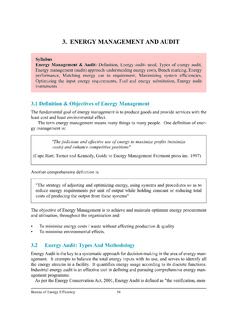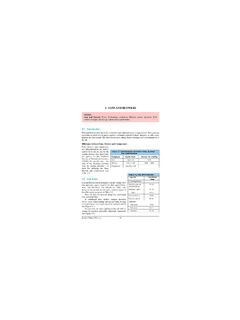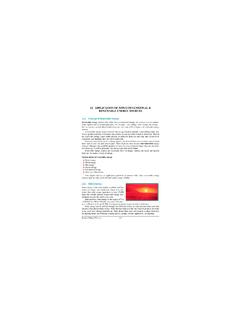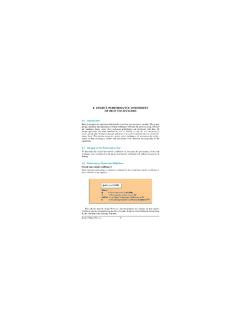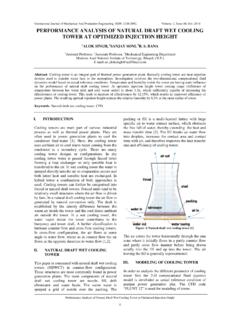Transcription of 7. COOLING TOWER - Bureau of Energy Efficiency
1 7. COOLING TOWER135 Bureau of Energy EfficiencySyllabusCooling TOWER :Types and performance evaluation, Efficient system operation, Flowcontrol strategies and Energy saving opportunities, Assessment of COOLING IntroductionCooling towers are a very important part of many chemical plants. The primary task of a cool-ing TOWER is to reject heat into the atmosphere. They represent a relatively inexpensive anddependable means of removing low-grade heat from COOLING water. The make-up water sourceis used to replenish water lost to evaporation. Hot water from heat exchangers is sent to thecooling TOWER . The water exits the COOLING TOWER and is sent back to the exchangers or to otherunits for further COOLING . Typical closed loop COOLING TOWER system is shown in Figure TOWER TypesCooling towers fall into two main categories: Natural draft and Mechanical draft.
2 Natural draft towers use very large concrete chimneys to introduce air through the to the large size of these towers , they are generally used for water flow rates above 45,000m3/hr. These types of towers are used only by utility power stations. Mechanical draft towers utilize large fans to force or suck air through circulated water. Thewater falls downward over fill surfaces, which help increase the contact time between the waterand the air - this helps maximise heat transfer between the two. COOLING rates of Mechanicaldraft towers depend upon their fan diameter and speed of operation. Since, the mechanical draftcooling towers are much more widely used, the focus is on them in this chapter. Figure COOLING Water SystemMechanical draft towersMechanical draft towers are available in the following airflow arrangements:1. Counter flows induced Counter flow forced Cross flow induced the counter flow induced draft design, hot water enters at the top, while the air is intro-duced at the bottom and exits at the top.
3 Both forced and induced draft fans are used. In cross flow induced draft towers , the water enters at the top and passes over the fill. Theair, however, is introduced at the side either on one side (single-flow TOWER ) or opposite sides(double-flow TOWER ). An induced draft fan draws the air across the wetted fill and expels itthrough the top of the Figure illustrates various COOLING TOWER types. Mechanical draft towers are avail-able in a large range of capacities. Normal capacities range from approximately 10 tons, m3/hr flow to several thousand tons and m3/hr. towers can be either factory built or fielderected - for example concrete towers are only field erected. Many towers are constructed so that they can be grouped together to achieve the desiredcapacity. Thus, many COOLING towers are assemblies of two or more individual coolingtowers or "cells.
4 " The number of cells they have, , an eight-cell TOWER , often refers to such towers . Multiple-cell towers can be lineal, square, or round depending upon the shapeof the individual cells and whether the air inlets are located on the sides or bottoms of of COOLING TowerThe basic components of an evaporative TOWER are: Frame and casing, fill, cold water basin,drift eliminators, air inlet, louvers, nozzles and and casing:Most towers have structural frames that support the exterior enclosures(casings), motors, fans, and other components. With some smaller designs, such as some glassfiber units, the casing may essentially be the frame. Fill: Most towers employ fills (made of plastic or wood) to facilitate heat transfer by maximis-ing water and air contact. Fill can either be splash or film type. With splash fill, water falls over successive layers of horizontal splash bars, continuouslybreaking into smaller droplets, while also wetting the fill surface.
5 Plastic splash fill promotesbetter heat transfer than the wood splash fill consists of thin, closely spaced plastic surfaces over which the water spreads, form-ing a thin film in contact with the air. These surfaces may be flat, corrugated, honeycombed, orother patterns. The film type of fill is the more efficient and provides same heat transfer in asmaller volume than the splash fill. Cold water basin: The cold water basin, located at or near the bottom of the TOWER , receivesthe cooled water that flows down through the TOWER and fill. The basin usually has a sump orlow point for the cold water discharge connection. In many TOWER designs, the cold water basinis beneath the entire fill. 7. COOLING Tower136 Bureau of Energy EfficiencyIn some forced draft counter flow design, however, the water at the bottom of the fill ischanneled to a perimeter trough that functions as the cold water basin.
6 Propeller fans are mount-ed beneath the fill to blow the air up through the TOWER . With this design, the TOWER is mountedon legs, providing easy access to the fans and their motors. 7. COOLING Tower137 Bureau of Energy EfficiencyFigure COOLING TOWER TypesDrift eliminators: These capture water droplets entrapped in the air stream that otherwisewould be lost to the atmosphere. Air inlet: This is the point of entry for the air entering a TOWER . The inlet may take up an entireside of a TOWER cross flow design or be located low on the side or the bottom of counter : Generally, cross-flow towers have inlet louvers. The purpose of louvers is to equal-ize air flow into the fill and retain the water within the TOWER . Many counter flow TOWER designsdo not require louvers. Nozzles: These provide the water sprays to wet the fill. Uniform water distribution at the top ofthe fill is essential to achieve proper wetting of the entire fill surface.
7 Nozzles can either befixed in place and have either round or square spray patterns or can be part of a rotating assem-bly as found in some circular cross-section : Both axial (propeller type) and centrifugal fans are used in towers . Generally, propellerfans are used in induced draft towers and both propeller and centrifugal fans are found in forceddraft towers . Depending upon their size, propeller fans can either be fixed or variable pitch. A fan having non-automatic adjustable pitch blades permits the same fan to be used over a widerange of kW with the fan adjusted to deliver the desired air flow at the lowest power consumption. Automatic variable pitch blades can vary air flow in response to changing load MaterialsIn the early days of COOLING TOWER manufacture, towers were constructed primarily of components included the frame, casing, louvers, fill, and often the cold water basin.
8 Ifthe basin was not of wood, it likely was of concrete. Today, TOWER manufacturers fabricate towers and TOWER components from a variety of mate-rials. Often several materials are used to enhance corrosion resistance, reduce maintenance, andpromote reliability and long service life. Galvanized steel, various grades of stainless steel,glass fiber, and concrete are widely used in TOWER construction as well as aluminum and vari-ous types of plastics for some towers are still available, but they have glass fiber rather than wood panels (casing)over the wood framework. The inlet air louvers may be glass fiber, the fill may be plastic, andthe cold water basin may be steel. Larger towers sometimes are made of concrete. Many towers casings and basins are con-structed of galvanized steel or, where a corrosive atmosphere is a problem, stainless a galvanized TOWER has a stainless steel basin.
9 Glass fiber is also widely used forcooling TOWER casings and basins, giving long life and protection from the harmful effects ofmany chemicals. Plastics are widely used for fill, including PVC, polypropylene, and other polymers. Treatedwood splash fill is still specified for wood towers , but plastic splash fill is also widely usedwhen water conditions mandate the use of splash fill. Film fill, because it offers greater heattransfer Efficiency , is the fill of choice for applications where the circulating water is generallyfree of debris that could plug the fill passageways. 7. COOLING Tower138 Bureau of Energy EfficiencyPlastics also find wide use as nozzle materials. Many nozzles are being made of PVC, ABS,polypropylene, and glass-filled nylon. Aluminum, glass fiber, and hot-dipped galvanized steel arecommonly used fan materials.
10 Centrifugal fans are often fabricated from galvanized fans are fabricated from galvanized, aluminum, or moulded glass fiber reinforced COOLING TOWER Performance7. COOLING Tower139 Bureau of Energy EfficiencyFigure Range and ApproachThe important parameters, from the point of determining the performance of COOLING towers , are:i)"Range" is the difference between the COOLING TOWER water inlet and outlet temperature.(See Figure ).ii)"Approach" is the difference between the COOLING TOWER outlet cold water temperatureand ambient wet bulb temperature. Although, both range and approach should be moni-tored, the 'Approach' is a better indicator of COOLING TOWER performance. (see Figure ).iii) COOLING TOWER effectiveness (in percentage) is the ratio of range, to the ideal range, ,difference between COOLING water inlet temperature and ambient wet bulb temperature,or in other words it is = Range / (Range + Approach).
